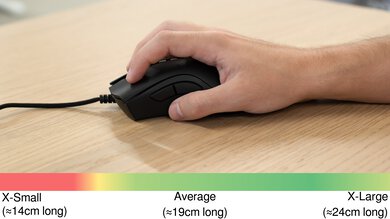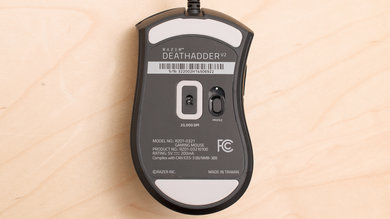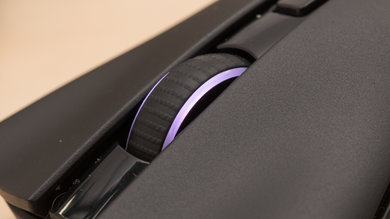The Razer DeathAdder V2 is an excellent FPS gaming mouse. It looks and feels almost identical to the Razer DeathAdder Elite, but has a much-improved cable, better feet, and a profile switch button. This mouse also now features onboard memory, so you can save your customization settings to the mouse, great if you want to use it on a Mac, as the Synapse 3 software isn't compatible with macOS. This mouse has a very wide and customizable CPI range, and its click latency is exceptionally low. It's well-suited for palm grip and should be comfortable for any hand size, though those with small hands likely won't find it comfortable for claw or fingertip grip.
Our Verdict
The Razer DeathAdder V2 is a decent office mouse. Its slightly ergonomic shape makes it comfortable to use for extended periods, and it has a fair amount of programmable buttons that you can map to help you switch between applications quickly. Unfortunately, its mouse wheel doesn't support horizontal or non-incremented scrolling, which makes it tougher to scroll through long documents. On the upside, it's suitable for almost any hand size, unless you use claw or fingertip grip, in which case small hands may have a hard time reaching all the buttons.
- Outstanding performance and customization options.
- Much-improved cable over previous versions.
- Great for most grips and hand sizes.
- Slightly too large for small hands.
- Not the best for portability.
The Razer DeathAdder V2 is an excellent FPS gaming mouse. Its click latency is extremely low, and you can set your own custom CPI setting within a very wide range. All of its buttons can be reprogrammed, and it's comfortable enough to use for long gaming marathons. It's great for palm grip for any hand size, though smaller hands may have a harder time with claw or fingertip grip.
- Outstanding performance and customization options.
- Much-improved cable over previous versions.
- Great for most grips and hand sizes.
- Slightly too large for small hands.
- Not the best for portability.
The Razer DeathAdder V2 is an excellent MMO mouse. While it doesn't have nearly as many buttons as a dedicated MMO mouse, all of the buttons it does have are programmable, which is great. It's comfortable enough to use for extended periods and has extremely low click latency. It's comfortable in palm grip for all hand sizes, and only those with small hands will have a hard time with claw or fingertip grip.
- Outstanding performance and customization options.
- Much-improved cable over previous versions.
- Great for most grips and hand sizes.
- Slightly too large for small hands.
- Not the best for portability.
- Outstanding performance and customization options.
- Much-improved cable over previous versions.
- Great for most grips and hand sizes.
- Slightly too large for small hands.
- Not the best for portability.
Changelog
- Updated Aug 19, 2025: We've converted this review to Test Bench 1.5.1. This update removes less relevant or redundant elements, including several videos. We've also adjusted our Sensor Latency testing, resulting in minor score changes. See our full 1.5.1 changelog for details.
- Updated Jan 05, 2024: We've updated the CPI graph displayed in the Sensor Latency section of this review. Our results remain the same, but these graphs have two new columns with results from the Delay At Half Movement and Delay To End Of Movement tests.
- Updated Dec 01, 2023: We've converted this review to Test Bench 1.5. This update adds a new Main Button test group, which provides button actuation data and switch information. We've also made minor changes to how we calculate the Office usage score. For more details, you can see our full changelog here.
- Updated Mar 24, 2023: We've added a link to the newly-reviewed Razer DeathAdder V3 in the Weight section of this review.
Check Price
Differences Between Sizes And Variants
There are no variants of this mouse. This is the upgraded version of the Razer DeathAdder Elite and the original Razer DeathAdder, which we haven't tested. If you're looking for a left-handed mouse, Razer makes a left-handed version of the original DeathAdder, though we haven't tested it.
Popular Mouse Comparisons
The Razer DeathAdder V2 is a decent upgrade over the Razer DeathAdder Elite. It's an excellent FPS gaming mouse. If you want something similar but with a more ergonomic shape, check out the Razer Basilisk V2. See our recommendations for the best wired mice, the best gaming mice, and the best Razer mice.
The Razer Viper and the Razer DeathAdder V2 are very similar performing mice, and their main differences are shape and weight. The Viper has a lower profile body, while the V2 has a higher back hump. The Viper is also lighter than the V2 and has an ambidextrous design, while the V2 is slightly heavier and has a right-handed design.
The Razer DeathAdder V2 and the Razer Basilisk V3 are wired gaming mice with comparable performance. The Basilisk has a somewhat more flexible cable, a slightly higher maximum CPI, and three additional buttons, including one additional side button. Also, its scroll wheel has L/R tilt buttons and free-scrolling, two features the DeathAdder V2 lacks. On the other hand, the DeathAdder V2 is considerably lighter. Both mice are suitable for all grip types and most hand sizes. However, both mice are unsuitable for small hands using a claw or fingertip grip.
The Razer DeathAdder V3 and the Razer DeathAdder V2 are mice in different generations from the same lineup. The newer DeathAdder V3 is significantly lighter and has a more flexible cable and a slightly modified shape. It also has improved sensor performance and supports a higher maximum polling rate of 8000Hz. On the other hand, the older DeathAdder V2 has RGB lighting, which the V3 lacks.
The Razer DeathAdder V2 and the Logitech G PRO X SUPERLIGHT are both excellent gaming mice, but the Razer is wired-only while the Logitech can be used wirelessly. The Razer is slightly wider and has a right-handed design that feels more comfortable overall. It also has more buttons and programmable inputs. On the other hand, the Logitech is great for most hand sizes and grip types, and it's very lightweight, so it should please fans of ultra-light gaming as well. It also has a wider CPI range and less CPI variation.
Test Results

The Razer DeathAdder V2 looks almost identical to the Razer DeathAdder Elite. The CPI switching buttons are a different shape and size, and the plastic around them is now glossy black. The mouse has a Razer logo on the back, which is RGB lit, and there is a second RGB zone in the mouse wheel.
This mouse is quite a bit lighter than the first generation, which is great. There's no weight optimization, other than if you bungee the cord. If you're interested in a newer version of this mouse that's significantly more lightweight. check out the Razer DeathAdder V3. Alternatively, if you're interested in a smaller and more lightweight version of this mouse check out the Razer DeathAdder V2 Mini.
The comfort of use for this mouse is great. It has a slight slant that makes it more designed for right-handed use, though it has rubber grips on either side of the mouse. Its long design is more suitable for palm or claw grip. If you want a non-slanted design with a lower back hump, check out the Razer Viper.
The Razer DeathAdder V2 is a wired-only mouse. If you're looking for a wireless mouse, you may want to check out the Razer Mamba Wireless or the Razer DeathAdder V2 X Hyperspeed.
Update 10/01/2020: We changed the cable score to be more consistent with other mice that have a braided cable. It has been reduced from 8.5 to 7.5.
The Razer DeathAdder V2 uses Razer's new and improved cable. It's a huge improvement over previous versions and feels very sturdy but is much more flexible and less rigid.
Update 10/01/2020: Fixed an error with the number of programmable inputs. We didn't count for the extra layer of inputs you get with the Hypershift button.
The Razer DeathAdder V2's buttons are excellent. According to Razer, the L/R click buttons use optical switches, though we don't currently test for this. Every button on this mouse is programmable, including the profile switch button on the underside of the mouse, and you get a Hypershift button to add an extra layer of customizable actions. If you'd like a cheaper option without buttons below its scroll wheel, check out the Razer DeathAdder Essential.
This mouse has exceptionally low click latency. It delivers a very responsive and consistent in-game experience for games in all genres.
The Razer DeathAdder V2's mouse wheel is decent, as it doesn't have a horizontal wheel or L/R tilt buttons. Its increments are fairly clicky, and it has a slightly different notch pattern than the Razer DeathAdder Elite.
The Razer DeathAdder V2 uses Razer's Synapse 3 software, which is great. Unlike the previous version, this mouse now has on-board memory so you can save your settings to the mouse and maintain them if you switch PCs.
Unfortunately, Razer's Synapse 3 software isn't compatible with macOS. On the upside, this mouse has on-board memory, so you can make changes on a Windows PC and they'll stick if you use the mouse on a Mac. If you want a mouse that has software that's compatible with macOS as well, take a look at the SteelSeries Rival 310, though it doesn't perform quite as well overall.












